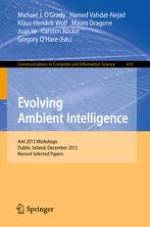This book constitutes the refereed proceedings of the workshops co-located with the 4th International Joint Conference on Ambient Intelligence, AmI 2013, held in Dublin, Ireland, in December 2013. The 33 revised full papers presented were carefully reviewed and selected from numerous submissions to the following workshops: 5th International Workshop on Intelligent Environments Supporting Healthcare and Well-being (WISHWell’13) 3d International workshop on Pervasive and Context-Aware Middleware (PerCAM’13), 2nd International Workshop on Adaptive Robotic Ecologies (ARE'13), International Workshop on Aesthetic Intelligence (AxI'13), First International Workshop on Uncertainty in Ambient Intelligence (UAmI13). The papers are organized in topical sections on intelligent environments supporting healthcare and well-being; adaptive robotic ecologies; uncertainty in ambient intelligence; aesthetic intelligence; pervasive and context-aware middleware.
